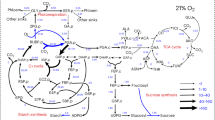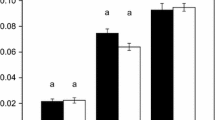Abstract
The rates of respiration in light and darkness, C i/C a and carbon isotope fractionation were investigated in glycine decarboxylase-deficient plants of barley, potato and Arabidopsis thaliana grown in climate chambers with controlled light intensity, temperature, humidity, irradiation and different CO2 concentrations (360, 700 and 1400 µl l−1) and compared to the wild-type plants. All photorespiration-impaired plants exhibited higher C i/C a and corresponding lower apparent water-use efficiencies, which were more expressed under high irradiance and elevated temperature. The mutants were depleted in 13C as compared to the wild-type plants, with a difference of up to 6‰ following growth in 360 µl l−1 CO2. We determined the carbon isotope content at different CO2 concentrations to calculate the contribution of both C i/C a and photorespiration for 13C/12C fractionation. The direct effect of photorespiration was in the range of 0.7–1.0‰, from which we calculated the value of fractionation at the site of glycine decarboxylation as being 10–13‰, which is in agreement with the previously reported carbon isotope discrimination exerted by the glycine decarboxylase. Respiratory rates, particularly in the light, were increased in the glycine decarboxylase mutants. The necessity of the maintenance of a high CO2 concentration near the site of carboxylation in chloroplasts in plants deficient in photorespiratory enzymes, requires an increased opening of the stomata with a corresponding decrease in water-use efficiency. It is concluded that photorespiration participates in the regulation of C i/C a and contributes to carbon isotope fractionation, both via effects on stomata and via discrimination of 13C in the glycine decarboxylase reaction.
Similar content being viewed by others
References
Amthor JS (2000) Direct effect of elevated CO2 on nocturnal in situ leaf respiration in nine temperate deciduous tree species is small. Tree Physiol 20: 139–144
Assmann SM (1999) The cellular basis of guard cell sensing of rising CO2. Plant Cell Environ 22: 629–637
Atkin OK, Millar AH, Gardeström P and Day DA (2000) Photosynthesis, carbohydrate metabolism and respiration in leaves of higher plants. In: Leegood RC, Sharkey TD and von Caemmerer S (eds) Photosynthesis: Physiology and Metabolism, pp 153–175. Kluwer Academic Publishers Dordrecht, The Netherlands
Bauwe H and Kokukisaoglu Ü (2003) Genetic manipulation of glycine decarboxylation. J Exp Bot 54: 1523–1535
Bernacchi CJ, Portis AR, Nakano H, von Caemmerer S and Long SP (2002) Temperature response of mesophyll conductance. Implications for the determination of Rubisco enzyme kinetics and for limitations to photosynthesis in vivo. Plant Physiol 130: 1992–1998
Blackwell RD, Murray AJS and Lea PJ (1990) Photorespiratory mutants of the mitochondrial conversion of glycine to serine. Plant Physiol 94: 1316–1322
Brugnoli E and Farquhar GD (2000) Photosynthetic fractionation of carbon isotopes. In: Leegood RC, Sharkey TD and von Caemmerer S (eds) Photosynthesis: Physiology and Metabolism, pp 399–434. Kluwer Academic Publishers Dordrecht, The Netherlands
Bruhn D, Mikkelsen TN and Atkin OK (2002) Does the direct effect of atmospheric CO2 concentration of leaf respiration vary with temperature? Responses in two species of Plantago that differ in relative growth rate. Physiol Plant 114: 57–64
Buckley TN, Mott KA and Farquhar GD (2003) A hydromechanical and biochemical model of stomatal conductance. Plant Cell Environ 26: 1767–1785
Bunce JA (2000) Responses of stomatal conductance to light, humidity and temperature in winter wheat and barley grown at three concentrations of carbon dioxide in the field. Global Change Biol 6: 371–382
Bunce JA (2001) Direct and acclimatory responses of stomatal conductance to elevated carbon dioxide in four herbaceous crop species in the field. Global Change Biol 7: 323–331
Cousson A (2000) Analysis of the sensing and transducing processes implicated in the stomatal responses to carbon dioxide in Commelina communis L. Plant Cell Environ 23: 487–495
Craig H (1957) Isotopic standards for carbon and oxygen and correction factors for mass-spectrometric analysis of carbon dioxide. Geochim Cosmochim Acta 12: 133–149
DeSilva DLR, Hetherington AM and Mansfield TA (1996) Where does all the calcium go? Evidence of an important regulatory role for trichomes in two calcicoles. Plant Cell Environ 19: 880–886
Di Marco G, Manes F, Tricoli D and Vitale E (1990) Fluorescence parameters measured concurrently with net photosynthesis to investigate chloroplastic CO2 concentration in leaves of Quercus ilex L. J Plant Physiol 136: 538–543
Drake BG, Gonzalez-Meler MA and Long SP (1997) More efficient plants: a consequence of rising atmospheric CO2? Annu Rev Plant Physiol Plant Mol Biol 48: 609–639
Duranceau M, Ghashghaie J and Brugnoli E (2001) Carbon isotope discrimination during photosynthesis and dark respiration in intact leaves of Nicotiana sylvestris: comparisons between wild type and mitochondrial mutant plants. Aust J Plant Physiol 28: 65–71
Evans JR and Loreto F (2000) Acquisition and diffusion of CO2 in higher plant leaves. In: Leegood RC, Sharkey TD and von Caemmerer S (eds) Photosynthesis: Physiology and Metabolism, pp 321–351. Kluwer Academic Publishers, Dordrecht, The Netherlands
Farquhar GD and Lloyd J (1993) Carbon and oxygen isotope effects in the exchange of carbon dioxide between terrestrial plants and the atmosphere. In: Ehleringer R, Hall AE and Farquhar GD (eds) Stable Isotopes and Plant Carbon-Water Relations, pp 47–70. Academic Press, New York
Farquhar GD, O'Leary MH and Berry JA (1982) On the relationship between carbon isotope discrimination and the intercellular carbon dioxide concentration in leaves. Aust J Plant Physiol 9: 121–137
Farquhar GD, Ehleringer JR and Hubick KT (1989) Carbon isotope discrimination and photosynthesis. Annu Rev Plant Physiol Plant Mol Biol 40: 503–537
Ghashghaie J, Duranceau M, Badeck F-W, Cornic G, Adeline M-T and Deleens E (2001) δ 13C of CO2 respired in the dark in relation to δ 13C of leaf metabolites: comparison between Nicotiana sylvestris and Helianthus annuus under drought. Plant Cell Environ 24: 505–515
Gillon JS and Griffiths H (1997) The influence of (photo)respiration on carbon isotope discrimination in plants. Plant Cell Environ 20: 1217–1230
Häusler RE, Bailey KJ, Lea PJ and Leegood PJ (1996) Control of photosynthesis in barley mutants with reduced activities of glutamine synthetase and glutamate synthase. III. Aspects of glyoxylate metabolism and effects of glyoxylate on the activation state of ribulose-1,5-bisphosphate carboxylase-oxygenase. Planta 200: 388–396
Heineke D, Bykova NV, Gardeström P and Bauwe H (2001) Metabolic response of potato plants to an antisense reduction of the P-protein of glycine decarboxylase. Planta 212: 880–887
Hetherington AM (2001) Guard cell signaling. Cell 107: 711–714
Igamberdiev AU and Lea PJ (2002) The role of peroxisomes in the integration of metabolism and evolution of land plants. Phytochemistry 60: 651–674
Igamberdiev AU, Zemlyanukhin AA and Rodionova LG (1988) Glycolate oxidase from wheat and sugarbeet leaves — catalytic properties and role in oxalate biosynthesis. Biochemistry (Moscow) 53: 1499–1505
Igamberdiev AU, Bykova NV, Lea PJ and Gardeström P (2001a) The role of photorespiration in redox and energy balance of photosynthetic plant cells: a study with a barley mutant deficient in glycine decarboxylase. Physiol Plant 111: 427–438
Igamberdiev AU, Ivlev AA, Bykova NV, Threlkeld CN, Lea PJ and Gardeström P (2001b) Decarboxylation of glycine contributes to carbon isotope fractionation in photosynthetic organisms. Photosynth Res 67: 177–184
Ivlev AA, Bykova NV and Igamberdiev AU (1996) Fractionation of carbon (13C/12C) isotopes in glycine decarboxylase reaction. FEBS Lett 386: 174–176
Laisk A (1977) Kinetics of Photosynthesis and Photorespiration in C3 Plants. Nauka, Moscow
Leegood RC, Lea PJ, Adcock MD and Häusler RE (1995) The regulation and control of photorespiration. J Exp Bot 46: 1397–1414
Leymarie J, Lasceve G and Vavasseur A (1999) Elevated CO2 enhances stomatal responses to osmotic stress and abscisic acid in Arabidopsis thaliana. Plant Cell Environ 22: 301–308
Lin G and Ehleringer JR (1997) Carbon isotope fractionation does not occur during dark respiration in C3 and C4 plants. Plant Physiol 114: 391–394
Lloyd J and Farquhar GD (1994) 13C discrimination during CO2 assimilation by the terrestrial atmosphere. Oecologia 99: 201–215
Long SP and Bernacchi CJ (2003) Gas exchange measurements, what can they tell us about the underlying limitations to photosynthesis? Procedures and sources of error. J Exp Bot 54: 2393–2401
Osmond CB, Badger MR, Maxwell K, Björkman O and Leegood RC (1997) Too many photons: photorespiration, photoinhibition and photooxidation. Trends Plant Sci 2: 119–121
Powles SB and Osmond CB (1978) Inhibition of the capacity and efficiency of photosynthesis in bean leaflets illuminated in a CO2-free atmosphere at low O2: a possible role for photorespiration. Aust J Plant Physiol 5: 619–629
Powles SB, Osmond CB and Thorne SW (1979) Photoinhibition of intact attached leaves of C3 plants illuminated in the absence of both CO2 and of photorespiration. Plant Physiol 64: 982–988
Rooney MA (1988) Short-term Carbon Isotope Fractionation in Plants. PhD thesis. University of Wisconsin, Madison, Wisconsin
Schwartz A, Ilan N and Grantz DA (1988) Calcium effects on stomatal movement in Commelina communis L. Use of EGTA to modulate stomatal response to light, KCl and CO2. Plant Physiol 87: 583–587
Sharkey TD (1988) Estimating the rate of photorespiration in leaves. Physiol Plant 73: 147–152
Somerville CR and Ogren WL (1982) Mutants of the cruciferous plant Arabidopsis thaliana lacking glycine decarboxylase activity. Biochem J 202: 373–380
von Caemmerer S and Evans JR (1991) Determination of the average partial pressure of CO2 in chloroplasts from leaves of several C3 species. Aust J Plant Physiol 18: 287–305
von Caemmerer S, Evans JR, Hudson GS and Andrews TJ (1994) The kinetics of ribulose bisphosphate carboxylase-oxygenase in vivo inferred from measurements of photosynthesis in leaves of transgenic tobacco. Planta 195: 88–97
Webb AAR, McAinsh MR, Mansfield TA and Hetherington AM (1996) Carbon dioxide induces increases in guard cell cytosolic free calcium. Plant J 9: 297–304
Webb AAR, Larman MG, Montgomery LT, Taylor JE and Hetherington AM (2001) The role of calcium in ABA-induced gene expression and stomatal movements. Plant J 26: 351–362
Wingler A, Lea PJ and Leegood RC (1997) Control of photosynthesis in barley plants with reduced activities of glycine decarboxylase. Planta 202: 171–178
Wingler A, Lea PJ and Leegood RC (1999a) Photorespiratory metabolism of glyoxylate and formate in glycine-accumulating mutants of barley and Amaranthus edulis. Planta 207: 518–526
Wingler A, Quick WP, Bungard RA, Bailey KJ, Lea PJ and Leegood RC (1999b) The role of photorespiration during drought stress, an analysis utilizing barley mutants with reduced activities of photorespiratory enzymes. Plant Cell Environ 22: 361–373
Wingler A, Lea PJ, Quick WP and Leegood RC (2000) Photorespiration, metabolic pathways and their role in stress protection. Phil Trans Royal Soc London B 355: 1517–1529
Winzer T, Heineke D and Bauwe H (2001) Growth and phenotype of potato plants expressing an antisense gene of P-protein of glycine decarboxylase under control of a promoter with preference for the mesophyll. Ann Appl Biol 139: 9–15
Author information
Authors and Affiliations
Rights and permissions
About this article
Cite this article
Igamberdiev, A.U., Mikkelsen, T.N., Ambus, P. et al. Photorespiration Contributes to Stomatal Regulation and Carbon Isotope Fractionation: A Study with Barley, Potato and Arabidopsis Plants Deficient in Glycine Decarboxylase. Photosynthesis Research 81, 139–152 (2004). https://doi.org/10.1023/B:PRES.0000035026.05237.ec
Issue Date:
DOI: https://doi.org/10.1023/B:PRES.0000035026.05237.ec




